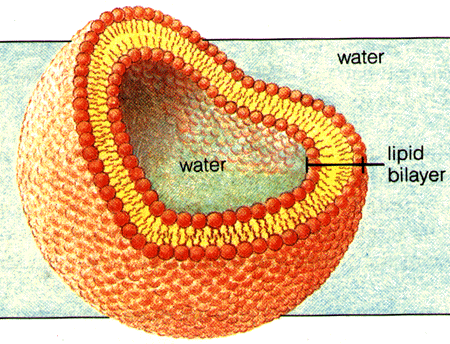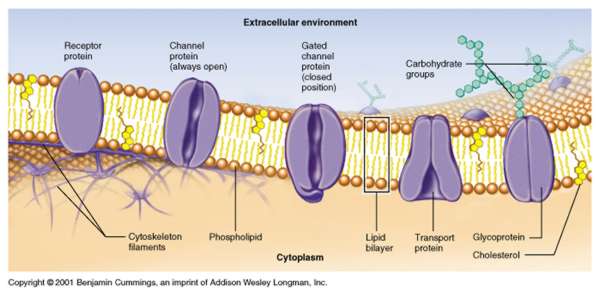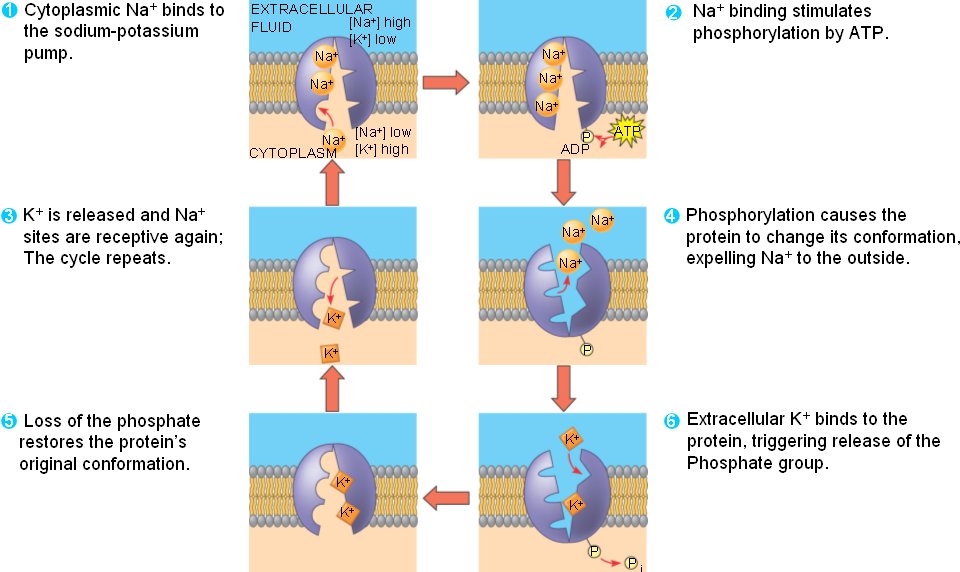| |
Membranes
Page history
last edited
by Darrell Sharp 11 years, 6 months ago
|
2.1 Cell Theory
2.2-2.3 Prokaryotic and Eukaryotic Cells
2.4 Membranes
2.5 Cell Division
|
|

|
|
2.4 Membranes
Homework
Resource:
Click4biology
|
|
2.4.1
Draw and label a diagram to show the structure of membranes.
|
|
Cell Membrane or Plasma Membrane

Another model...

John Kyrk Animation
|
|
2.4.2
Explain how the hydrophobic and hydrophilic properties of phospholipids help to maintain the structure of cell membranes.
|
|
Phospholipid Molecules
- Polar "head" - hydrophilic ("water loving")
-
- Nonpolar "tails" - hydrophobic ("water fearing")

Phopholipid Bilayer Structure

The extracellular fluid and the cytosol are mostly water.
- polar water molecules attract the polar heads.
- polar water molecules repel the nonpolar tails.
The phospholipids arrange themselves in a double layer (bilayer):
- the heads facing the outside of the cell and facing the inside of the cell.

Cholesterol and Proteins

Cholesterol molecules make the plasma membrane more rigid (less flexible).
Proteins - two groups:
- peripheral proteins - attached to the surface of the membrane.
- integral proteins - extend into or through the phospholipid bilayer.
|
|
2.4.3
List the functions of membrane proteins.
|
|
Membrane Proteins

Membrane Protein Functions
- Receptor Protein - has a specific shape to match a specific signal molecule (hormone), responds by signalling inside the cell.
- Enzyme - catalyst for chemical reactions, on the inside or outside (peripheral).
- Channel Protein - passive transport of ions, polar molecules, or large molecules.
- Gated Channel Protein - passive transport, but can open or close.
- Protein Pump - active transport of substances, requires energy.
- Glycoprotein - communication: identifies cell or cell function to other cells.
- Electron Transport Chain - move electrons and pump hydrogen ions across the membrane.
Resource:
Click4Biology
|
|
2.4.4
Define diffusion and osmosis.
2.4.5
Explain passive transport across membranes by simple diffusion and facilitated diffusion.
|
|
Passive Transport
- movement of substances without using energy.
Examples
- diffusion: movement of substances from an area of high concentration to an area of low concentration.
- facilitated diffusion: diffusion though a channel protein.
- osmosis: diffusion of water.
Background Information
- solution: mixture made by dissolving a solute into a solvent.
- dissolve: to break apart one substance into small, separate particles and become thoroughly mixed in another substance.
- solute: the substance with the smaller amount.
- solvent: the substance with the larger amount.
- concentration: the amount of solute in a solution.
solute + solvent = solution Example: salt + water = salt water
Passive transport video
|
|
2.4.6
Explain the role of protein pumps and ATP in active transport across membranes.
|
|
Active Transport
- using energy (ATP) to transport substances across a membrane
Using Protein Pumps
- moves substances from low concentration to high concentration.
- requires energy from ATP to function
Diagram of the sodium-potassium pump.
Note: follow the arrows - the numbers are incorrect.

Active transport video
|
|
2.4.7
Explain how vesicles are used to transport materials within a cell between the rough endoplasmic reticulum, Golgi apparatus and plasma membrane.
|
|
Vesicle Transport

|
|
2.4.8
Describe how the fluidity of the membrane allows it to change shape, break and re-form during endocytosis and exocytosis.
|
|
Active Transport Using Vesicles
Endocytosis and exocytosis video
Fluid Mosaic Model video
|
| |
Home
Membranes
|
|
Tip: To turn text into a link, highlight the text, then click on a page or file from the list above.
|
|
|
Comments (0)
You don't have permission to comment on this page.